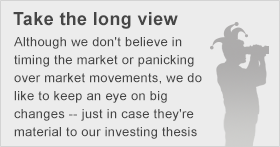
On Tuesday, the Dow Jones Industrials (^DJI +0.48%) rose 27 points, marking the Dow's third-straight day of gains. Some sluggish economic data wasn't enough to take away the positive sentiment among investors, who seem confident that the U.S. economy's unimpressive pace of growth can accelerate before the bull market ends. Yet. also looming in the background was the fact that today marked the first day of a two-day meeting of the Federal Open Market Committee, the Federal Reserve's monetary-policy-making body. Investors want to know whether the Fed will do anything to surprise investors, or whether policymakers will continue on their current course to end quantitative easing by the end of the year.

Federal Reserve. Source: Dan Smith.
What the market wants
At this point, most investors expect the Fed to continue the tapering of its bond-buying activity under quantitative easing, which has occurred at a measured pace throughout 2014. After reaching a peak of $85 billion monthly, the FOMC has reduced the amount of bond purchases by $10 billion on four separate occasions, with its current monthly level of $45 billion established in May. If the Fed keeps cutting its buying by the same amount each meeting, then quantitative easing would end entirely in mid-December.
Yet, two bigger questions face the Fed. The first is when to start considering raising short-term interest rates, which have been locked near zero for more than five years. After the tech bust, the Fed raised rates from 1% to 5.25% within the span of just a couple years, and the impact on those who had accumulated substantial amounts of debt during the low-rate environment of the early 2000s helped contribute to what eventually became the mortgage-market meltdown. With the even longer period of low rates this time around, many investors fear that the long bull market in the Dow Jones Industrials and other asset classes might well unravel once the Fed reverses course and makes short-term borrowing more expensive. Yet, some Fed officials believe that, even in the longer term, raising short-term rates to 5% would be too extreme given the tepid growth in the economy.
The second thing the Fed needs to decide is whether it will start reducing the size of its balance sheet. During the course of the past several years, large bond purchases have ballooned the Fed's assets. Although the natural maturity of Treasury and mortgage-backed securities should allow the Fed's balance sheet to return to lower levels over time, some advocates argue that the central bank should make deliberate asset sales back into the bond market. Others worry that sales would disrupt the bond market.
For Dow investors, the biggest impact of bond-market uncertainty falls on financial stocks. Travelers (TRV 0.78%) has a large bond portfolio, and 2013's mid-year rate jump caused a measurable drop in unrealized appreciation on that portfolio. JPMorgan Chase (JPM 0.08%) warned that its bond portfolio was also at risk from higher rates, although other aspects of the bank's business would benefit from rate increases based on Fed policy.
The key for investors in the Dow Jones Industrials is how the Fed communicates its future message. As long as it's able to give a clear future course of action without causing panic, then the Dow likely won't suffer. But if investors get news they don't want to hear, then it could send the Dow sharply lower in short order.






